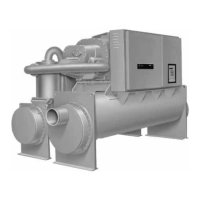Installation, Operation and Maintenance 9 - 3
Oil Charging Procedure
It is critical to fill the oil lines feeding the compressor
when charging a system with oil. The diagnostic
“Loss of oil at the compressor” will be generated if
the oil lines are not full on start-up.
Refer to
Table 29
for recommended oil charge
levels.To properly charge the system with oil, follow
the steps below:
1 Locate the 1/4” schrader valve between the ball
valve and oil filter (or the ball valve and oil cooler,
if so equipped).
2 Loosely connect oil pump to schrader valve called
out in step 1.
3 Operate oil charging pump until oil appears at the
charging valve connection; then tighten the
connection.
Note: To keep air from entering the oil, the charging
valve connection must be air- tight.
4 Close the ball valve just upstream of the schrader
valve connected to the oil pump. This will allow
the oil to travel through the oil lines to the
compressor first rather than directly to the oil
sump.
5 At the UCP2 display panel, press <Service Tests>
and enter the password (++--++) followed by
<Enter>).
6 Press <enter> to access the service tools group.
7 Press <next> 12 times to display “Master Oil Line
Solenoid Valve: [Mode]”.
8 Press ‘+’ to change the mode from “Auto” to “On”.
9 This will energize the solenoid to allow the oil to
travel from the schrader to the compressor. It
takes approximately 2 gallons of oil to fill the lines.
10 Monitor the next display in the menu which is “Oil
Loss Level Sensor Status: [s]. This display shows
whether the optical sensor is seeing oil (wet) or if
it is not (dry). After adding approximately 2 gallons
the status of the sensor will change from dry to
wet.
11 Once the optical oil level sensors reads wet, de-
energize the master solenoid by changing the
“Master Oil Line Solenoid Valve:” from “On” to
“Auto”.
12 Open the ball valve just upstream of the schrader
connected to the oil pump. This will allow the
remainder of the charge to flow to the oil sump.
NOTE: The remainder of the oil charge can be
charged into the 1/4” service valve located at the
bottom of the sump if a larger connection is
preferred.
Replacing the Main Oil Filter (Hot Filter)
The filter element of the unit-mounted oil filter
generally must be changed if the oil flow is
sufficiently obstructed. Two things can happen: first,
the chiller may shut down on a “Low Oil Flow”
diagnostic, or secondly, the compressor may shut
down on a “Loss of Oil at Compressor (Running)
diagnostic. If either of these diagnostics occurs, it is
likely the oil filter needs replacement.
Specifically, the filter must be changed if the pressure
drop between the two service valves in the
lubrication circuit exceeds the maximum level as
given in
Figure 34
. This chart shows the relationship
between the pressure drop measured in the
lubrication circuit as compared with operating
pressure differential of the chiller (as measured by
pressures in the condenser and evaporator).
Normal pressure drops between the service valves of
the lubrication circuit are shown by the lower curve.
The upper curve represents the maximum allowable
pressure drop and indicates when the oil filter must
be changed. Pressure drops that lie between the
lower and upper curves are considered acceptable.
For a chiller equipped with an oil cooler, add 5 psid to
the values shown in
Figure 34
. For example, if the
system pressure differential was 80 psid, then the
clean filter pressure drop would be approximately 15
psid (up from 10 psid). For a chiller with an oil cooler
and operating with a dirty oil filter, the maximum
allowable pressure drop would be 28 psid (up from
23 psid).
Under normal operating conditions the element
should be replaced after the first year of operation
and than as needed thereafter.

